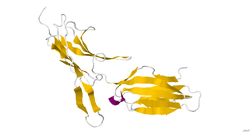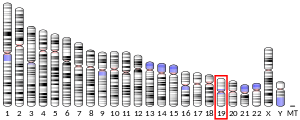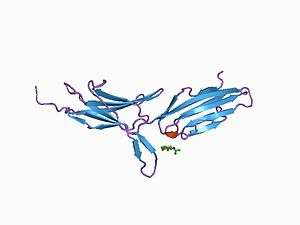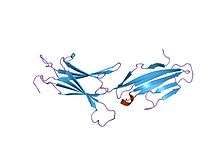Addressin
Addressin also known as mucosal vascular addressin cell adhesion molecule 1 (MAdCAM-1) is a protein that in humans is encoded by the MADCAM1 gene.[3][4][5]
Addressin is an extracellular protein of the endothelium of venules.
Addressins are the ligands to the homing receptors of lymphocytes.[6] The task of these ligands and their receptors is to determine which tissue the lymphocyte will enter next. They carry carbohydrates in order to be recognized by L-selectin.
Function
The protein encoded by this gene is an endothelial cell adhesion molecule that interacts preferentially with the leukocyte beta7 integrin LPAM-1 (alpha4 / beta7), L-selectin, and VLA-4 (alpha4 / beta1) on myeloid cells to direct leukocytes into mucosal and inflamed tissues. It is a member of the immunoglobulin superfamily and is similar to ICAM-1 and VCAM-1.[3]
In terms of migration, MADCAM is selectively expressed on mucosal endothelial cells, driving memory T-cell re-circulation through mucosal tissues. In contrast, and indeed the main difference between the two molecules, ICAM molecules are involved with naive T-cell re-circulation. Whereas MADCAM is selectively expressed, ICAM is broadly expressed on inflamed endothelium.
References
- GRCh38: Ensembl release 89: ENSG00000099866 - Ensembl, May 2017
- "Human PubMed Reference:". National Center for Biotechnology Information, U.S. National Library of Medicine.
- "Entrez Gene: mucosal vascular addressin cell adhesion molecule 1".
- Shyjan AM, Bertagnolli M, Kenney CJ, Briskin MJ (April 1996). "Human mucosal addressin cell adhesion molecule-1 (MAdCAM-1) demonstrates structural and functional similarities to the alpha 4 beta 7-integrin binding domains of murine MAdCAM-1, but extreme divergence of mucin-like sequences". J. Immunol. 156 (8): 2851–7. PMID 8609404.
- Leung E, Berg RW, Langley R, Greene J, Raymond LA, Augustus M, Ni J, Carter KC, Spurr N, Choo KH, Krissansen GW (1997). "Genomic organization, chromosomal mapping, and analysis of the 5' promoter region of the human MAdCAM-1 gene". Immunogenetics. 46 (2): 111–9. doi:10.1007/s002510050249. PMID 9162097.
- Addressin Archived 2016-12-01 at the Wayback Machine at eMedicine Dictionary
Further reading
- Ohara H, Isomoto H, Wen CY, et al. (2003). "Expression of mucosal addressin cell adhesion molecule 1 on vascular endothelium of gastric mucosa in patients with nodular gastritis". World J. Gastroenterol. 9 (12): 2701–5. doi:10.3748/wjg.v9.i12.2701. PMC 4612036. PMID 14669317.
- Ikeda S, Kudsk KA, Fukatsu K, et al. (2003). "Enteral feeding preserves mucosal immunity despite in vivo MAdCAM-1 blockade of lymphocyte homing". Ann. Surg. 237 (5): 677–85, discussion 685. doi:10.1097/01.SLA.0000064364.40406.EA. PMC 1514523. PMID 12724634.
- Tan K, Casasnovas JM, Liu JH, et al. (1998). "The structure of immunoglobulin superfamily domains 1 and 2 of MAdCAM-1 reveals novel features important for integrin recognition". Structure. 6 (6): 793–801. doi:10.1016/S0969-2126(98)00080-X. PMID 9655832.
- de Château M, Chen S, Salas A, Springer TA (2001). "Kinetic and mechanical basis of rolling through an integrin and novel Ca2+-dependent rolling and Mg2+-dependent firm adhesion modalities for the alpha 4 beta 7-MAdCAM-1 interaction". Biochemistry. 40 (46): 13972–9. doi:10.1021/bi011582f. PMID 11705388.
- Miles A, Liaskou E, Eksteen B, et al. (2008). "CCL25 and CCL28 promote alpha4 beta7-integrin-dependent adhesion of lymphocytes to MAdCAM-1 under shear flow". Am. J. Physiol. Gastrointest. Liver Physiol. 294 (5): G1257–67. doi:10.1152/ajpgi.00266.2007. PMID 18308860.
- Kimura K, Wakamatsu A, Suzuki Y, et al. (2006). "Diversification of transcriptional modulation: large-scale identification and characterization of putative alternative promoters of human genes". Genome Res. 16 (1): 55–65. doi:10.1101/gr.4039406. PMC 1356129. PMID 16344560.
- Grayson MH, Hotchkiss RS, Karl IE, et al. (2003). "Intravital microscopy comparing T lymphocyte trafficking to the spleen and the mesenteric lymph node". Am. J. Physiol. Heart Circ. Physiol. 284 (6): H2213–26. doi:10.1152/ajpheart.00999.2002. PMID 12586641.
- Fujisaki S, Tomita R, Park YJ, et al. (2004). "Semiquantative analysis of expression of mucosal addressin cell adhesion molecule-1 during small bowel graft rejection in rats". Transplant. Proc. 36 (2): 348–9. doi:10.1016/j.transproceed.2003.12.010. PMID 15050155.
- Nishimura T (2003). "Expression of potential lymphocyte trafficking mediator molecules in the mammary gland". Vet. Res. 34 (1): 3–10. doi:10.1051/vetres:2002045. PMID 12588680.
- Ogawa H, Binion DG, Heidemann J, et al. (2005). "Mechanisms of MAdCAM-1 gene expression in human intestinal microvascular endothelial cells". Am. J. Physiol., Cell Physiol. 288 (2): C272–81. doi:10.1152/ajpcell.00406.2003. PMID 15483224.
- Ruiz-Velasco N; Guerrero-Esteo M; Briskin MJ; Teixidó J (2000). "The alpha(4) integrin subunit Tyr(187) has a key role in alpha(4)beta(7)-dependent cell adhesion". J. Biol. Chem. 275 (10): 7052–9. doi:10.1074/jbc.275.10.7052. PMID 10702270.
- Di Sabatino A, Rovedatti L, Rosado MM, et al. (2009). "Increased expression of mucosal addressin cell adhesion molecule 1 in the duodenum of patients with active celiac disease is associated with depletion of integrin alpha4beta7-positive T cells in blood". Hum. Pathol. 40 (5): 699–704. doi:10.1016/j.humpath.2008.10.014. PMID 19157500.
- Bowlus CL, Karlsen TH, Broomé U, et al. (2006). "Analysis of MAdCAM-1 and ICAM-1 polymorphisms in 365 Scandinavian patients with primary sclerosing cholangitis". J. Hepatol. 45 (5): 704–10. doi:10.1016/j.jhep.2006.03.012. PMID 16750586.
- Ambruzova Z, Mrazek F, Raida L, et al. (2009). "Possible impact of MADCAM1 gene single nucleotide polymorphisms to the outcome of allogeneic hematopoietic stem cell transplantation". Hum. Immunol. 70 (6): 457–60. doi:10.1016/j.humimm.2009.03.008. PMID 19286444.
- Ota T, Suzuki Y, Nishikawa T, et al. (2004). "Complete sequencing and characterization of 21,243 full-length human cDNAs". Nat. Genet. 36 (1): 40–5. doi:10.1038/ng1285. PMID 14702039.
- Arihiro S, Ohtani H, Suzuki M, et al. (2002). "Differential expression of mucosal addressin cell adhesion molecule-1 (MAdCAM-1) in ulcerative colitis and Crohn's disease". Pathol. Int. 52 (5–6): 367–74. doi:10.1046/j.1440-1827.2002.01365.x. PMID 12100519.
- Strausberg RL, Feingold EA, Grouse LH, et al. (2002). "Generation and initial analysis of more than 15,000 full-length human and mouse cDNA sequences". Proc. Natl. Acad. Sci. U.S.A. 99 (26): 16899–903. doi:10.1073/pnas.242603899. PMC 139241. PMID 12477932.
- Grimwood J, Gordon LA, Olsen A, et al. (2004). "The DNA sequence and biology of human chromosome 19". Nature. 428 (6982): 529–35. doi:10.1038/nature02399. PMID 15057824.
- Shroff HN, Schwender CF, Baxter AD, et al. (1998). "Novel modified tripeptide inhibitors of alpha 4 beta 7 mediated lymphoid cell adhesion to MAdCAM-1". Bioorg. Med. Chem. Lett. 8 (13): 1601–6. doi:10.1016/S0960-894X(98)00286-8. PMID 9873398.
- Dando J, Wilkinson KW, Ortlepp S, et al. (2002). "A reassessment of the MAdCAM-1 structure and its role in integrin recognition" (PDF). Acta Crystallogr. D. 58 (Pt 2): 233–41. doi:10.1107/S0907444901020522. PMID 11807247.
External links
- vascular+addressins at the US National Library of Medicine Medical Subject Headings (MeSH)
- Human MADCAM1 genome location and MADCAM1 gene details page in the UCSC Genome Browser.
- Overview of all the structural information available in the PDB for UniProt: Q13477 (Mucosal addressin cell adhesion molecule 1) at the PDBe-KB.
This article incorporates text from the United States National Library of Medicine, which is in the public domain.




